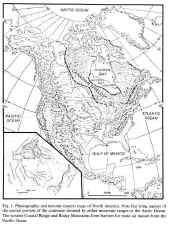|
Earth-Science
Reviews, 22 (1985), 107-140
COLD
CLIMATE PEAT FORMATION IN CANADA, AND ITS RELEVANCE TO LOWER PERMIAN COAL
MEASURES OF AUSTRALIA
I.P.
MARTINI1 and W.A. GLOOSCHENKO2
1Department
of Land Resource Science, University of Guelph, Guelph, Ontario, Canada N1G 2W1
2Aquatic Ecology
Division, National Water Research Institute, Burlington, Ontario, Canada L0R 1H0
¡¡
 Canada
is a vast, cold country. Large expanses of wetlands occur whose characters
change predictably over continental distances along north-south temperature
gradients and coastal-inland precipitation trends. The changing climatic
conditions during the Holocene have influenced the initiation and rates of peat
formation. For instance, most of the peats of south-central Canada are not older
than 5000 years B.P. Those in the Arctic regions are fossil deposits of the
hypsithermal times of 7-8000 years B.P., maintained at the surface because of
the low rates of peat oxidation. Canada
is a vast, cold country. Large expanses of wetlands occur whose characters
change predictably over continental distances along north-south temperature
gradients and coastal-inland precipitation trends. The changing climatic
conditions during the Holocene have influenced the initiation and rates of peat
formation. For instance, most of the peats of south-central Canada are not older
than 5000 years B.P. Those in the Arctic regions are fossil deposits of the
hypsithermal times of 7-8000 years B.P., maintained at the surface because of
the low rates of peat oxidation.
An analysis of the environments of formation and of the stratigraphy of
recent peats, which formed under cold to cold-temperate climate in Canada, forms
the basis for a comparative study and a better understanding of the Permo-Carboniferous
coals of Gondwanaland (Brazil, South Africa and Australia).
Much of the stratigraphic complexities that occur in the peat sequences
are blurred out during organic decomposition and metamorphism leading to coal
formation. However, some of the major features of the sequences that develop in
string fens (from basal sedge peats up to sedge-woody peats), and in boreal and
cold-temperate bogs and swamps (from basal lacustrine deposits with some
reworked and algal rich sediments, grading upward into sedge peats, to Sphagnum-sedge
peat, to Sphagnum-woody or just woody peats) may be recognizable in
banded coal seams. It is suggested that future detailed comparative microfacies
analyses of the cold peat sequences of Canada and the Lower Permian coal seams
of Australia will allow better reconstructions and understanding of ancient
wetlands, without exclusively using the less appropriate, albeit better known,
recent models of subtropical swamps.
|